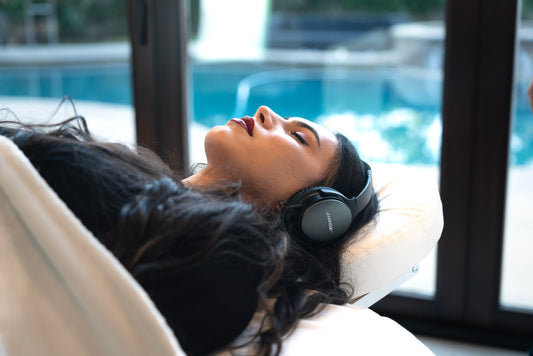Collection: What is Vibroacoustic Therapy?
Introduction to Vibroacoustic Therapy:
Vibroacoustic therapy is a non-invasive treatment that uses sound frequencies and vibrations to promote relaxation, reduce pain, and enhance overall well-being. This therapy involves the use of specialized devices such as mats, chairs, or beds that emit low-frequency vibrations and soothing sounds.
Benefits of Vibroacoustic Therapy:
-
Stress Reduction: The gentle vibrations and calming sounds can help reduce stress and induce a deep sense of relaxation.
-
Pain Management: Vibroacoustic therapy has been shown to alleviate various types of pain, including chronic musculoskeletal pain and tension headaches.
-
Improved Sleep & Insomnia: Many individuals report better sleep quality and enhanced sleep patterns after regular sessions of vibroacoustic therapy.
-
Mood Enhancement: The therapeutic effects of sound and vibration can uplift mood, reduce anxiety, and improve overall emotional well-being.
-
Muscle Relaxation: The vibrations from the therapy can help relax tense muscles and promote greater flexibility and range of motion.
-
Enhanced Circulation: The gentle rhythmic vibrations can improve blood flow and circulation throughout the body, aiding in the delivery of oxygen and nutrients to tissues.
-
Immune System Support: Some research suggests that vibroacoustic therapy may boost the immune system by reducing stress levels and promoting relaxation.
-
Sensory Stimulation: The combination of sound and vibration can provide sensory stimulation, making it a beneficial therapy for individuals with sensory processing disorders.
-
Mind-Body Connection: Vibroacoustic therapy can help foster a deeper connection between the mind and body, promoting a sense of harmony and well-being.
Clinical Studies on Vibroacoustic Therapy:
Low-Frequency Sound Stimulation (LFSS) Clinical Study
Title: The Effect of Low-Frequency Sound Stimulation on Patients with Fibromyalgia: A Clinical Study
Results: Showed statistically significant improvements across most metrics: FIQ improved by 81%, JSS by 90%, and PDI by 49.1%. Some patients reduced or discontinued medication, and functional measures also improved.
https://pmc.ncbi.nlm.nih.gov/articles/PMC4325896/
Vibroacoustic Stimulation Benefits for Insomnia
Title: Vibroacoustic (Auditory + Vibratory) Stimulation for Insomnia.
Results: ISI improvement: a drop from ~13 to ~9 points in the intervention group—a meaningful clinical improvement in insomnia severity. Control group showed negligible change PMC.
Sleep duration: Intervention group gained ~48 extra minutes of sleep per night; control group saw almost no change.
https://pmc.ncbi.nlm.nih.gov/articles/PMC7024098/
Vibroacoustic Sound Massage and Stress Reduction
Title: Effects of Vibroacoustic Stimulation on Psychological, Physiological, and Cognitive Stress.
This study examined whether a Vibroacoustic Sound Massage (VSM)—combining tactile vibration with ambient soundscapes—can measurably reduce stress, both mentally and physically.
Results:
-
Cognitive Stress (EEG Measures)
Theta/Beta Ratio (TBR) — a marker of concentration: focusing balance — showed a significant decrease, indicating improved focus during and following VSM compared to baseline and resting controls.
-
Physiological Stress (Autonomic Nervous System)
Beta/Alpha Ratio (BAR) — associated with arousal levels — dropped significantly during VSM as compared to higher arousal stages, showing relaxation occurred during and after VSM, although similar relaxation was observed in rest conditions.
Frontal Alpha Asymmetry (FAA) — a potential marker of emotional well-being — did not show statistically significant change; however, variability in well-being scores reduced post-intervention, especially for individuals starting with lower levels.
-
Subjective Well-Being
Concentration and relaxation improved as evidenced by EEG changes (not self-report alone), though self-reported well-being did not significantly increase.
https://pmc.ncbi.nlm.nih.gov/articles/PMC11436230/
Vibroacoustic Therapy for Chronic Back and Shoulder Pain
Title: Treatment of chronic back pain using indirect vibroacoustic therapy: A pilot study (2018)
Key Points:
Conducted over 12 weeks, this pilot study evaluated the efficacy of low-frequency sound wave stimulation (16–160 Hz) delivered through both hands and feet.
Participants: 23 individuals with chronic pain—11 with shoulder pain and 12 with low back pain.
Frequency: Sessions occurred three times per week.
Outcomes Measured:
- Primary: Pain intensity (via Visual Analog Scale, P-VAS)
- Secondary: Pain-related disability (Pain Disability Index, PDI) and physical quality of life (SF-12)
Results:
- Pain Reduction: Mean decrease of 3.5 points on the P-VAS.
- 65% of participants experienced a reduction of at least 3 points
- Improved Functionality: Mean reduction in PDI was 13.5 points.
- 52% saw at least a 10-point drop in disability
https://pubmed.ncbi.nlm.nih.gov/30149436/
Conclusion:
Vibroacoustic therapy is a promising holistic approach to enhancing physical and mental health. With its proven benefits in stress reduction, pain management, sleep improvement, and mood enhancement, this therapy offers a non-invasive and relaxing way to support overall well-being.
Call or text for more information today 619-944-1959
Playlist
-
Oscilla Meditation Sound Bed
Regular price $2,499.00 USDRegular priceUnit price / per

